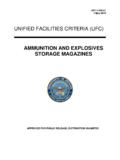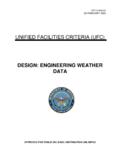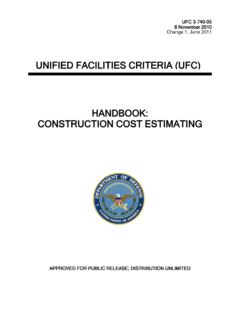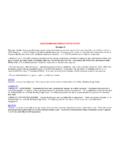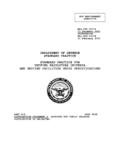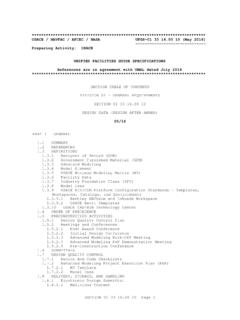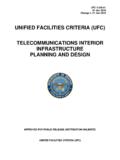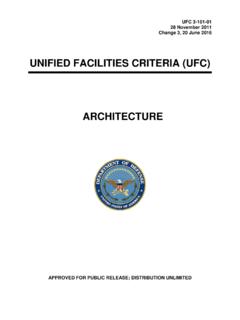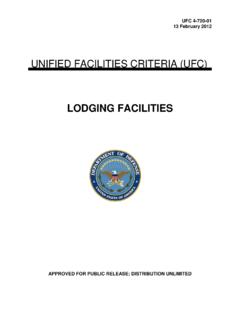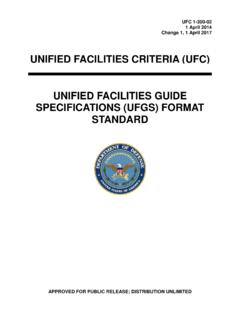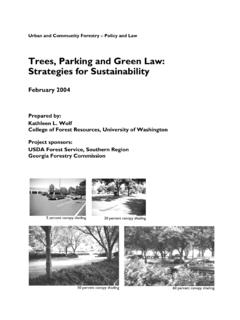Transcription of UNIFIED FACILITIES CRITERIA (UFC) LOW IMPACT …
1 UFC 3-210-10. 1 June 2015. Change 1, 1 February 2016. UNIFIED FACILITIES CRITERIA (UFC). LOW IMPACT development . APPROVED FOR PUBLIC RELEASE; DISTRIBUTION UNLIMITED. UFC 3-210-10. 1 June 2015. Change 1, 1 February 2016. UNIFIED FACILITIES CRITERIA (UFC). LOW IMPACT development . Any copyrighted material included in this UFC is identified at its point of use. Use of the copyrighted material apart from this UFC must have the permission of the copyright holder. ARMY CORPS OF ENGINEERS. NAVAL FACILITIES ENGINEERING COMMAND (Preparing Activity). AIR FORCE CIVIL ENGINEER CENTER. Record of Changes (changes are indicated by \1\ .. /1/). Change No. Date Location 1 1 Feb 2016 Updated Table B-4 to correct the description under "Soils" for "Bio-retention". Added of underdrains. to the end. The sentence should read in its entirety . Soil limitations can be overcome with use of underdrains . This UFC supersedes UFC 3-210-10, dated 15 Novemeber 2010.
2 UFC 3-210-10. 1 June 2015. Change 1, 1 February 2016. FOREWORD. The UNIFIED FACILITIES CRITERIA (UFC) system is prescribed by MIL-STD 3007 and provides planning, design, construction, sustainment, restoration, and modernization CRITERIA , and applies to the Military Departments, the Defense Agencies, and the DoD Field Activities in accordance with USD(AT&L) Memorandum dated 29 May 2002. UFC will be used for all DoD projects and work for other customers where appropriate. All construction outside of the United States is also governed by Status of Forces Agreements (SOFA), Host Nation Funded Construction Agreements (HNFA), and in some instances, Bilateral Infrastructure Agreements (BIA.). Therefore, the acquisition team must ensure compliance with the more stringent of the UFC, the SOFA, the HNFA, and the BIA, as applicable. UFC are living documents and will be periodically reviewed, updated, and made available to users as part of the Services' responsibility for providing technical CRITERIA for military construction.
3 Headquarters, Army Corps of Engineers (HQUSACE), Naval FACILITIES Engineering Command (NAVFAC), and Air Force Civil Engineer Center (AFCEC) are responsible for administration of the UFC system. Defense agencies should contact the preparing service for document interpretation and improvements. Technical content of UFC is the responsibility of the cognizant DoD working group. Recommended changes with supporting rationale should be sent to the respective service proponent office by the following electronic form: CRITERIA Change Request (CCR). The form is also accessible from the Internet sites listed below. UFC are effective upon issuance and are distributed only in electronic media from the following source: Whole Building Design Guide web site Refer to UFC 1-200-01, General Building Requirements, for implementation of new issuances on projects. JAMES C. DALTON, JOSEPH E. GOTT, Chief, Engineering and Construction Chief Engineer Army Corps of Engineers Naval FACILITIES Engineering Command JOE SCIABICA, SES.
4 MICHAEL McANDREW. Director Director, FACILITIES Investment and Management UFC 3-210-10. 1 June 2015. Change 1, 1 February 2016. UNIFIED FACILITIES CRITERIA (UFC). REVISION SUMMARY SHEET. Document: UFC 3-210-10, Low IMPACT development Superseding: This UFC supersedes UFC 3-210-10, dated 15 November 2010. Description of changes: This revision clarifies applicability of Low IMPACT development (LID) requirements to projects with various mixtures of facility types, clarifies project documentation requirements and designer responsibilities, and clarifies the relationship of Energy Independence and Security Act (EISA) requirements to Clean Water Act (CWA) requirements. Reasons for changes: Several years of implementation experience identified the following issues: Ambiguity and inconsistency in applying LID requirements to projects with mixtures of building and pavement areas, particularly with regard to calculation of the applicable footprint.
5 Unclear and/or infeasible documentation requirements. Unclear relationship between EISA requirements and CWA requirements, resulting in potential to inappropriately include LID design goals with CWA. permits. IMPACT : This change will improve: Objectivity and consistency in applying stormwater management requirements of EISA section 438 to DoD construction projects. Documentation of project LID goals and performance. Understanding of the relationship between EISA and CWA requirements to preclude inappropriate CWA permit stipulations. Unification issues: None. UFC 3-210-10. 1 June 2015. Change 1, 1 February 2016. TABLE OF CONTENTS. CHAPTER 1 INTRODUCTION .. 1. 1-1 BACKGROUND .. 1. 1-2 PURPOSE AND SCOPE .. 1. 1-3 DEFINITION OF LOW IMPACT development .. 1. 1-4 APPLICABILITY .. 2. 1-5 GENERAL BUILDING REQUIREMENTS .. 2. 1-6 REFERENCES .. 2. CHAPTER 2 TECHNICAL REQUIREMENTS .. 3. 2-1 DESIGN OBJECTIVE .. 3. Establishing Pre- development Condition.
6 3. Design Storm Event .. 3. Maximum Extent Technically Feasible (METF).. 3. Technical Infeasibility .. 4. 2-2 POST-CONSTRUCTION ANALYSIS .. 4. 2-3 DOCUMENTATION .. 4. CHAPTER 3 PLANNING AND DESIGN .. 7. 3-1 HYDROLOGIC ANALYSIS .. 7. Approved Methodologies .. 7. Other Methodologies .. 7. 3-2 TR-55 METHODOLOGY .. 7. Storm Event .. 8. Total Depth .. 8. Design Storage .. 9. 3-3 DESIGN OPTIONS FOR LID FEATURES .. 9. Engineered Natural 9. Engineered Subsurface Treatment .. 10. Non-Potable Rainwater 10. Green (Vegetative) Roofs .. 10. 3-4 TIME OF CONCENTRATION FOR PRE- AND POST- development . CONDITIONS .. 10. Stormwater Flow Segments .. 11. 3-5 OFF-SITE OPTIONS .. 11. 3-6 CLEAN WATER ACT PERMITS .. 11. 3-7 OTHER DESIGN REQUIREMENTS .. 11. i UFC 3-210-10. 1 June 2015. Change 1, 1 February 2016. Sustainable Design .. 12. Architectural Compatibility .. 12. Base Design and development Documents .. 12. Anti-Terrorism (AT).
7 12. Airfield CRITERIA .. 12. APPENDIX A REFERENCES .. 13. APPENDIX B BEST PRACTICES .. 14. B-1 BACKGROUND .. 14. B-2 PLANNING .. 17. The Planning Component .. 17. Cost Analysis .. 18. EPA LID 19. B-3 STORMWATER MANAGEMENT .. 19. Hydrologic Cycle .. 20. Conventional Stormwater Management Vs. LID .. 21. Water Quality and Pollution Prevention .. 24. Design Inputs .. 24. Precipitation Data .. 24. Low- IMPACT Design Elements for Stormwater Management .. 25. B-4 LID DESIGN .. 28. Introduction .. 28. Hydrologic Analysis .. 28. Design Objective and Predevelopment 32. Design Considerations .. 32. Gaining Acceptance of LID Options .. 35. Construction Permit Process .. 35. Conclusions .. 36. APPENDIX C GLOSSARY .. 39. C-1 ACRONYMS AND 39. C-2 DEFINITION OF TERMS .. 40. ii UFC 3-210-10. 1 June 2015. Change 1, 1 February 2016. FIGURES. Figure 2-1 Implementation of EISA Section 438 .. 6. Figure B-1 Typical Bio-infiltration Rain Garden'.
8 30. TABLES. Table B-1 EPA Websites related to 16. Table B-2 Summary of Concepts of SWM and LID Techniques .. 22. Table B-3 Comparison of Conventional SWM and LID Technologies .. 23. Table B-4 Summary of LID Techniques, Constraints, Requirements and Applicability .. 26. Table B-5 Summary of Hydrologic Functions of LID Practices .. 27. Table B-6 Initial Abstraction for Indicated Soil Types .. 29. Table B-7 Analysis Method Comparison .. 37. Table B-8 Summary of Rainfall Analysis (1978-1997) .. 38. iii UFC 3-210-10. 1 June 2015. Change 1, 1 February 2016. CHAPTER 1 INTRODUCTION. 1-1 BACKGROUND. Increased impervious area changes the natural flow of water and decreases the quantity of water that infiltrates into the ground. Increased runoff increases sediment transport and decreases water quality. Low IMPACT development (LID) seeks to restore pre- development infiltration rates at the project site through one or more LID Integrated Management Practices (IMPs).
9 In December 2007, Congress enacted the Energy Independence and Security Act (EISA) of 2007. This legislation established into law new stormwater design requirements for federal agencies to develop and redevelop applicable FACILITIES in a manner that maintains or restores stormwater runoff to the Maximum Extent Technically Feasible (METF) with regard to the temperature, rate, volume, and duration of flow. In December of 2009, Environmental Protection Agency (EPA) issued EPA 841-B-09-001. EPA 841-B-09-001 provides technical guidance to assist federal agencies in implementing EISA Section 438 and was intended solely as guidance. Deputy Under Secretary of Defense (Installations and Environment) memorandum of 19. January 2010 directs DoD components to implement EISA Section 438 using LID. techniques in accordance with the methodology illustrated in Figure 2-1 and further described below. This policy directs DoD to implement EISA Section 438 EPA technical guidance in accordance with DoD Policy on Implementing EISA Section 438.
10 Where DoD policy or the CRITERIA provided in this UFC conflicts with EPA Technical Guidance, the DoD policy and UFC CRITERIA govern. Individual Services may have more stringent implementation and applicability requirements relating to Low IMPACT development . 1-2 PURPOSE AND SCOPE. This UFC provides technical CRITERIA , technical requirements, and references for the planning and design of applicable DoD projects to comply with stormwater requirements under Section 438 of the Energy Independence and Security Act (EISA) enacted in December 2007 (hereafter referred to as EISA Section 438) and the Deputy Under Secretary of Defense DoD policy on implementation of stormwater requirements under EISA section 438. 1-3 DEFINITION OF LOW IMPACT development . LID is a stormwater management strategy designed to maintain site hydrology and mitigate the adverse impacts of stormwater runoff and nonpoint source pollution. LID actively manages stormwater runoff by mimicking a project site's pre- development hydrology using design techniques that infiltrate, store, and evaporate runoff close to its source of origin.
